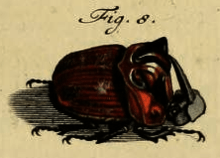Oxysternon festivum
| Oxysternon festivum | |
|---|---|
 | |
| Original Illustration of Oxysternon festivum by Rösel, designated as holotype.[1] | |
| Scientific classification | |
| Kingdom: | Animalia |
| Phylum: | Arthropoda |
| Class: | Insecta |
| Order: | Coleoptera |
| Family: | Scarabaeidae |
| Subfamily: | Scarabaeinae |
| Genus: | Oxysternon |
| Species: | O. festivum |
| Binomial name | |
| Oxysternon festivum Linnaeus, 1767[2] | |
Oxysternon festivum is a species of dung-beetle of the scarab beetle family.
Description

Oxysternon festivum has a colored dorsum and black head and underside, the pronotum is smooth. As most Oxysternon species, it has considerable variation in color, ranging from the typical coppery-red to entirely black, and including yellow-red and green forms. The black form is apparently restricted to the Island of Trinidad and thus considered as a separate subspecies (O. festivum nigerrimum Arnaud, 2002).[1]
The species reaches a length of about 16–31 millimetres (0.63–1.22 in) and shows sexual polymorphism. Major males are horned and substantially bigger than the hornless female, while minor males are hornless and often smaller than females. Females and small males differ in the form of the transverse carina.[1]
Taxonomy and nomenclature
Oxysternon festivum was among the first dung beetle species studied by zoologist in the early XVIII century. The first illustration of a „exceedingly beautiful shining gold and red, three horned beetle” was published in 1747 by August Johann Rösel von Rosenhof, and a first description was done by Gronovius in 1764, but the names applied were non-binomial and therefore invalid for nomenclatural purposes.[3][4][5] It was later re-described by Linnaeus under the name of Scarabaeus festivus, and was subsequently included in most publications regarding exotic insects in the late XVIII and early XIX century.[6][7][8][9][10]
O. festivum was once assigned to the genus Sternaspis, but the name was preoccupied and thus invalid. Laporte, writing under the pen name of Le Compte de Castelnau, proposed the genus Oxysternon to include several species of Phaneus-like species with a long, spiniform extension of the anterior angle of the metasternum. O. festivum was later designated as the type species of this genus.[6][11]
Two color forms were described as aberrations by Olsoufieff, and later formalised as subspecies by Arnaud, using the names O. festivum viridanum for the green form and O. festivum nigerrimum for the black form. However the green coloration is apparently part of the phenotypical variation of the species and thus is not recognized as a separate subspecies.[1]
Behaviour
.jpg)
.jpg)
The distinct male morphotypes are associated to different reproductive tactics: major males fight for females and guard and defend burrows actively, while minor males evade fights and try to sneak to the burrows to mate with females.[12]
This species is attracted to dung, carrion and fruits as food resources, but are only known to breed on dung and carrion.[11][13]
Distribution
This species is mostly restricted to the Guiana Shield and can be found in French Guiana, Guyana, Suriname, Venezuela, Brazil, Colombia, and Trinidad.[14][15]
Habitat
Oxysternon festivum lives in forest but can tolerate certain degree of habitat perturbation.[15]
References
- 1 2 3 4 Edmonds, W.D.; Zidek, J. (2004). "Revision of the Neotropical Dung Beetle Genus Oxysternon (Scarabaeidae: Scarabaeinae: Phanaeini)". FOLIA HEYROVSKYANA. 11: 1–58.
- ↑ Linné, Carl von (1767). Systema naturae : per regna tria natura, secundum classes, ordines, genera, species, cum characteribus, differentiis, synonymis, locis (Ed. 12, reformata. ed.). Holmiae :Impensis direct. Laurentii Salvii. Retrieved 18 June 2016. pag. 552
- ↑ Rösel, August Johan (1764–1768). De natuurlyke historie der insecten (Dutch translation ed.). Haarlem: C. H. Bohn en H. de Wit. pp. 2nd Volume, Part 1, pag. 29–30, Tab. B. Fig. 8. Retrieved 24 June 2016., pag. 29
- ↑ Gronovius, Laurentius Theodorus (1781). Zoophilacium Gronovianum : exhibens animalia quadrupeda, amphibia, pisces, insecta, vermes, mollusca, testacea, et zoophyta. Lugduni Batavorum :Apud Theodorum Haak et Socium et Samuelem et Johannem Luchtmans. Retrieved 19 June 2016., pag. 149
- ↑ Wheeler, Alwyne C. (2011). "THE ZOOPHYLACIUM OF LAURENS THEODORE GRONOVIUS". Journal of the Society for the Bibliography of Natural History. 3 (3): 152–157. doi:10.3366/jsbnh.1956.3.3.152.
- 1 2 Castelnau, M. (Le Comte de) (1850). Histoire naturelle des insectes, coléoptères. Paris, France: Société Bibliophile. pp. Tome deuxieme, Premiere partie. Retrieved 17 June 2016., pag. 82
- ↑ Olivier, Guillaume Antoine (1789). Entomologie, ou, Histoire naturelle des insectes : avec leurs caractères génériques et spécifiques, leur description, leur synonymie, et leur enluminée / Coléoptères. Paris, France: De l'Imprimerie de Baudoin. Retrieved 17 June 2016., pag. 110
- ↑ Gesellschaft Naturforschende Ärzte (1775). Onomatologia Historiae Naturalis Completa oder vollständiges ..., Volume 6. Ulm, Frankfurt und Leipzig: Stettinische Handlung. pp. 917. Retrieved 18 June 2016.
- ↑ Schoenherr, Carl Johan (1806). Synonymia insectorum, oder: Versuch einer synonymie aller bisher bekannten. p. 35. Retrieved 18 June 2016.
- ↑ Fabricius, Johann Christian (1781). Species insectorum. Hamburgi et Kilonii: Impensis Carol. Ernest. Bohnii. Retrieved 18 June 2016., pag. 23
- 1 2 Edmonds, W. D. (1972). "Comparative Skeletal Morphology, Systematics and Evolution of the Phanaeine Dung Beetles (Coleoptera: Scarabaeidae)". The University of Kansas science bulletin. 49 (11): 731–874. Retrieved 17 June 2016.
- ↑ Rowland, JM; Emlen, DJ. "Two thresholds, three male forms result in facultative male trimorphism in beetles". Science. 323: 773–776.
- ↑ Silvius, KM; Fragoso, JMV (2002). "Pulp handling by vertebrate seed dispersers increases palm seed predation by bruchid beetles in the northern Amazon". J Ecol. 90: 1024–1032. doi:10.1046/j.1365-2745.2002.00728.x.
- ↑ Ferrer‐Paris, José R.; Rodríguez, Jon Paul; Sánchez‐Mercado, Ada (2013). "Optimización del muestreo de invertebrados tropicales: Un ejemplo con escarabajos coprófagos (Coleoptera: Scarabaeinae) en Venezuela". Revista de Biología Tropical. 61 (1): 89–100. doi:10.15517/rbt.v61i1.10941.
- 1 2 Ferrer-Paris, José R; Lozano, Cecilia; Cardozo-Urdaneta, Arlene; Thomas Cabianca, Arianna. "Indicative response of Oxysternon festivum Linné (Coleoptera: Scarabaidae) to vegetation condition in the basin of the Orinoco river, Venezuela". Journal of Insect Conservation. in press. doi:10.1007/s10841-016-9886-6.